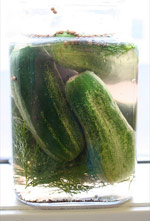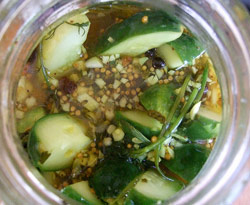Stop! Pickle Time
August 13, 2010
 “Pickles remind people of their grandmas,” says Todd Champagne of Happy Girl Kitchen. “A lot of good memories start with how things taste and smell and I think pickling really conjures up a different time for people.”
“Pickles remind people of their grandmas,” says Todd Champagne of Happy Girl Kitchen. “A lot of good memories start with how things taste and smell and I think pickling really conjures up a different time for people.”
Happy Girl Kitchen has been selling traditional, fermented half-sour pickles at the Ferry Plaza this summer. And, Todd says, “People have fun eating them in the market place like a popsicle.” Half-sours are a seasonal item that, unlike a completely sour pickle, still has some of the crunch and flavor of a raw cucumber. (If you’ve ever been to a Jewish deli, half-sours are what get placed on the table for munching on before the sandwich arrives.) Of course, if left to ferment for longer half-sours turn translucent and become whole sours.
What’s Old is New Again
Todd also teaches regular pickling classes, where he instructs students to make both fermented pickles and “quick pickles” with vinegar. The two techniques, he says, ultimately achieve the same aim, which is the protection of the vegetables with a strong acid solution. That can be achieved by directly adding vinegar, he says, or you can create the acid through a fermentation process. The nutritional make up, however, is different. “I always say that the probiotic qualities of fermented pickles make them a nourishing meal, whereas vinegar pickles are an enticing condiment.”
Fermented pickles also need to be refrigerated, which explains why the vinegar version appeared in the first place. “Vinegar pickles reached their apex in the post-war years, when everyone was growing victory gardens and raising their own food,” says Todd. “And there was war time mentality; canned pickles are shelf-stable and can be put in bomb shelters.”
Pickle Tips
 Fermenting pickles, like sauerkraut, can take some getting used to, mainly when it comes to what Todd calls “the scum” that forms on the surface of the brine. “People get scared off when they see mold floating on the top of their crock,” he says. “But that’s just a surface phenomenon. The vegetables themselves are protected by the salty brine.”
Fermenting pickles, like sauerkraut, can take some getting used to, mainly when it comes to what Todd calls “the scum” that forms on the surface of the brine. “People get scared off when they see mold floating on the top of their crock,” he says. “But that’s just a surface phenomenon. The vegetables themselves are protected by the salty brine.”
Because the fermentation can be arrested at many points, pickle makers also have a say in the flavor they’d like to achieve. Todd likes to inspire people to experiment and think beyond a pre-determined “best by” date. “People ask how I know when these are ready; I always say ‘taste them!’”
Todd is extra cautious when discussing canned pickles, mainly because – unlike jams and other fruit-based canned items – most vegetables tend to be low in acid, meaning they require a strong enough acid solution to be safely canned without the danger of botulism.
“To safely can your vegetables in a hot water bath, be sure the recipe you’re following is intended for canning and has a strong enough vinegar – water solution.” Once you’ve mastered the basics, Todd says, it’s time to experiment. “We tried pickling potatoes once and it was disgusting; everything else is basically fair game.”
On top of teaching pickling and other preservation techniques, Happy Girl has organized a buying club called The Food Preservationists that offers bulk quantities of local produce for canners at a discount.
Topics: Culinary
